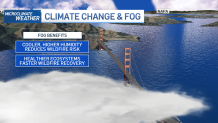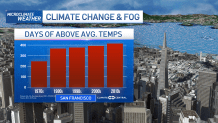The Bay Area is known around the world for it’s classic fog pattern that rolls through the Golden Gate Gap and can bring much needed summertime cooling.
While we can usually expect that fog pattern to get going in June there’s been a decreasing amount of it over the past several decades. So before we dive into the data, what’s so important about that fog? Well, not only can it break a heat wave pattern with chilly air but it also increases humidity which helps to lower immediate fire danger. Ecosystems are also healthier and we can recover from wildfires much faster.

However, as our climate has changed during the past few decades there has been a noticeable drop in the amount of Summer fog moving through San Francisco. The data below shows over the past 100 years we’ve seen a -34.5% decrease in fog which equates to about 3 to 4 hour less fog per day. This is bringing lower humidity, higher wildfire risk and stressed ecosystems.

Checkout the bar chart below and you’ll see in the 1970s we average around 200 days of above average temperatures in San Francisco but in the 2010’s we averaged over 400 days. So, this warmer weather trend is leading to less fog development.

You can find out more about how the Bay Area climate is changing in a series of stories the Microclimate Weather Team worked on across the Bay Area.
329 medal events. 32 sports. Endless drama. Catch all the action at the Paris Olympics. Sign up for our free Olympics Headlines newsletter.


